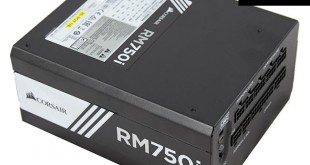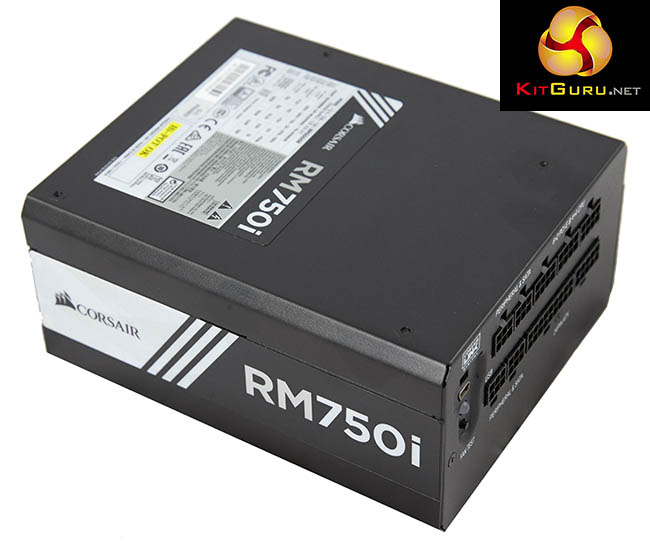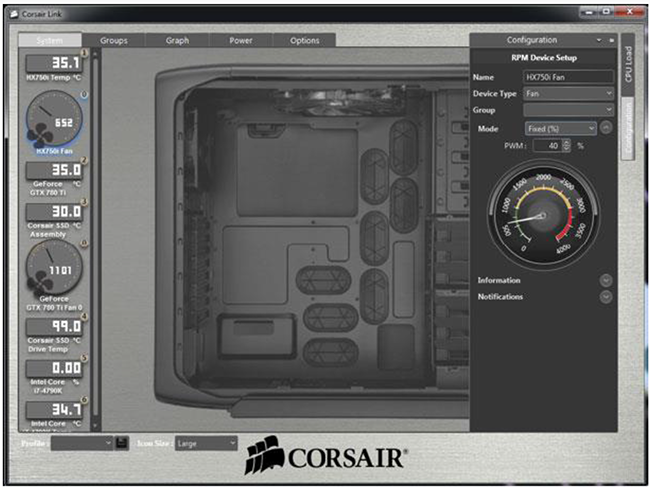
Corsair have just released their new range of RMi power supplies and we analyse their 750 watt model in this particular review today. If you visit the front page of Kitguru.net, you will see we also have published a review of their more expensive 1000 watt unit. This particular 750 watt PSU will target a wide demographic of enthusiast user, as it is priced at just under £110 inc vat in the UK. It carries 80 Plus Gold certification, is fully modular and has a switchable +12V configuration – offering single or multi rail operation. On a positive note, Corsair say they are using all Japanese 105c capacitors – something we always like to see.

Corsair have incorporated a fluid dynamic bearing fan in all RMi Series power supplies, designed to reduce noise output. Additionally Corsair have spent time selecting the components to ensure coil whine isn't an issue – extremely important as this issue has been raised many times by KitGuru readers in recent months.

The RMi supply has a digital output for Corsair Link monitoring capabilities. There is also a Zero Fan mode to ensure minimum noise levels when the power supply is running with a low power demand – the fan should only spin when the unit is placed under heavy demand. Corsair Link version 3.1.5570 or newer is needed for full RMi support.
RMi vs. RM: The Similarities
- 80 PLUS Gold Certified: Less heat generated and lower operating costs
- Fully Modular Cable Interface: Allows users to only install the cables they require, thus reducing clutter and improving airflow
- ZeroRPM Fan Mode up to 40% Load: Near silent operation at low and medium loads
- Silent Component Selection: Stringent QC implementation minimizes “coil whine” issues
- LLC Resonant Mode Topology w/ DC to DC: Improves efficiency, voltage regulation and ensures compatibility with 4th Generation and newer Intel processors.
RMi vs. RM: The Differences
- 7 Year Warranty: Upgraded from RM’s 5 year warranty
- ALL Japanese Capacitors: Ensures long life and best in class performance throughout the life of the product
- Rated for Full Output at 50°C: 10°C higher operating temperature than RM at 40°C
- Fluid Dynamic Bearing Fan: Longer life than RM’s rifle bearing and lower noise than dual ball-bearing fans
- Digital Output for Additional Corsair Link Monitoring Capabilities: Adds features to RM’s Link capabilities, such as the ability to monitor power in, out, efficiency, output voltages and temperature, as well as DC load and fan speed
- Additional Corsair Link Control Capabilities: Create a custom fan profile and toggle +12V rail from multiple to single rail mode.
 KitGuru KitGuru.net – Tech News | Hardware News | Hardware Reviews | IOS | Mobile | Gaming | Graphics Cards
KitGuru KitGuru.net – Tech News | Hardware News | Hardware Reviews | IOS | Mobile | Gaming | Graphics Cards



How well does a 750W PSU perform with dual 390X ?
@disqus_iWBVSACAxw:disqus ◬✈◭✈◮✔ Use Your Free Time….➨✈✔✈➨✔ Just Make A Huge profit Only doing Simplly work Of Google Tasks….. LAST thursday I bought a gorgeous BMW since getting a check for $9693 this-past/month and just over 10k this past month . it’s definitly the best-job I’ve ever had . I started this eight months/ago and right away began to earn minimum $83 per-hr . —>
☄☄☄☞ https://www.GenuineOnlineJobsOpportunity.com
That’s kind of pushing it to the limits.
The MSI R9 390X (only one) averages 344W during gaming..
During Furmark it does 424W. A 1000-1200W PSU would be better suited, especially if you are going to overclock as well.
http://www.techpowerup.com/reviews/MSI/R9_390X_Gaming/28.html